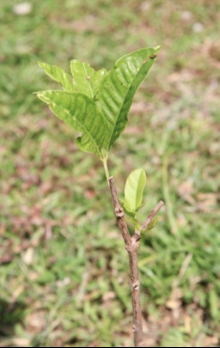Serai Kayu
| Serai Kayu | |
| Scientific Name | Syzygium polyanthum (Wight) Waplers |
| Family | Myrtaceae |
| Common Name | Salam, Indonesian Bay Leaf |
 |
{slider=Geographical Distributions}
Origin South East Asia (Burma to Indonesia).
{/slider}
{slider=Plant Material of Interests}
The leaves of the plant are widely used as spice
{/slider}
{slider=General Appearances}
Broadly spaced veins, 7-11 perleaf, Flowers pinkish colour as they mature
{/slider}
{slider=Chemical Contents}
Pheophorbide-α, methyl pheophorbide-α, methyl hydroxypheophorbide-α, pheophorbide-β and hydroxypheophorbide-b (Har LW et al 2012). Gallic acid and caffeic acid (Har LW & Ismail S. 2012).
Phytochemical analysis revealed that carbohydrate, tannin, alkaloid, steroid, triterpenoid, and flavonoid were present in the extracts of S. polyanthum leaves and ripened and unripe fruits, while saponin was only present in the ripened fruit extract ( Kusuma I.W. et al 2011)
Campest-4-en-3-one
{/slider}
{slider=Traditional Uses}
The leaf and bark have been used as traditional remedies to treat diarrhea, rheumatism and anti-hyperuricemia.
To treat ulcer: take leaves approximately 12 sheets of boiled with water half liter, simmer until a quater of an hour, and added sugar to taste, after cold drink like tea water.
To treat diarrhea: Take leaves 15 sheets of boiled with water two glasses, simmer for ten minutes. Add salt , filtered and drink.
To treat diabetes mellitus take 20 sheets of fresh leves, wash with clean, then boiled with three glasses of water until the volume of 1 glass, filtered, and drink twice a day before meals. It also lower hypertension (1).
{/slider}
{slider=Pharmacology}
Acetylcholinesterase inhibitors
The methanol extract of S. polyanthum leaves and the ethyl acetate extract leaves were potential as acetylcholinesterase inhibitors. The IC50 values of the extract were 47.30 ± 3.54 and 45.10 ± 8.06 µg/mL when IC50 value of physostigmine was 0.01± 0.02 µg/ml-1(Darusman L.K., et al 2013).
Antioxidant activity
Antioxidant activity of methanol extracts were 21.24±1.14 and 13.70 ±0.24ug/mL-1 (Darusman L.K., et al 2013). The oxidation of linoleic acid was effectively inhibited by S. polyanthum leaf methanolic extract with 91.43±2.52 %. The plant extracts exhibited no cytotoxic effect against Vero cell line (Perumal S. et al 2012).
S. polyanthum ripened fruit displayed significant antioxidant activity (90%) in comparison to ascorbic acid (95%) The antioxidant activity was determined with a 1,1-diphenyl-2-picrylhydrazyl radical scavenging assay ( Kusuma I.W. et al 2011).
Others
The three acybenzene derivatives(1-3) and campest-4-en-3-one exhibited a significant protein tyrosine phosphatade 1B inhibitory activity with IC50 values of 13.1 ±0.1, 5.55 ± 0.15, 4.01±0.26 and
10.4±0.5µM (Saifudin A. et al 2012).
{/slider}
{slider=Reference}
Har LW, ShaariK, Boon LH, Kamarulzaman FA, Ismail IS (2012). Two new phloroglucinol derivatives and five photosensitizing pheophorbides from Syzygium polyanthum leaves (Salam). Nat Prod Commun. Vol 7 (8), Pg 1033-1036.
Har L. W. & Ismail I. S. (2012). Antioxidant activity, total phenolics and total flavonoids of Syzygium polyanthum (Wight) Walp leaves. Int J. Med Arom. Plants Vol 2(2) Pg 219-228.
http://rahmaherbalstore.blogspot.com/2011/04/syzygium-polyanthum-for-diabetes.html (1)
Latifah K. Darusman, Wulan Tri Wahyuni and Farahdina Alwi, 2013. Acetylcholinesterase Inhibition and Antioxidant Activity of Syzygium cumini, S. aromaticum and S. polyanthum from Indonesia. Journal of Biological Sciences, 13: 412-416.
Kusuma I.W., H. Kuspradini, E. T. Arung, F. Aryani, Y.H. Min, J.S. Kim & Y.Kim (2011). Biological activity and phytochemical analysis od three Indonesian medicinal plants, Murraya koenigii, Sysygium polyanthum and Zingiber purpurea. Journal of acupuncture and meridian studies Vol 4(1) Pg 75-9. http://www.researchgate.net/publication/50867345.
Perumal S., R. Mahmud & S. P. Piaru (2012). Potential Antiradical Activity and Cytotoxicity Assessment of Ziziphus mauritiana and Syzygium polyanthum. International Journal of Pharmacology 8 (6) Pg 535-541.
Saifudin A., K. Tanaka, S. Kadota & Y. Tezuka (2012). Protein Tyrosine Phosphatase 1B (PTP1B)- Inhibiting Constituents from the Leaves of Syzygium polyanthum. Planta Med 78 (12) Pg 1378-1381.
{/slider}
- Last updated on .
- Hits: 3550
